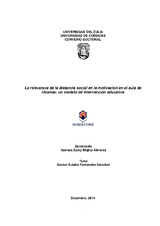Mostrar el registro sencillo del ítem
La relevancia de la distancia social en la motivación en el aula de idiomas: un modelo de intervención educativa
| dc.contributor.advisor | Fernández Sánchez, Eulalio | |
| dc.contributor.author | Mujica Almarza, Asmara Zulay | |
| dc.date.accessioned | 2015-01-12T09:19:50Z | |
| dc.date.available | 2015-01-12T09:19:50Z | |
| dc.date.issued | 2015 | |
| dc.identifier.uri | http://hdl.handle.net/10396/12495 | |
| dc.description.abstract | El objetivo principal del presente estudio fue diseñar un modelo de intervención educativa para abordar la distancia social y optimizar la motivación hacia el aprendizaje de LE en los estudiantes de Idiomas Modernos de la Universidad del Zulia. La investigación estuvo delimitada a los estudiantes de Idiomas Modernos de la Universidad del Zulia, durante el 2º período del año 2011. Para estudiar la distancia social se partió de teorías propuestas durante los setenta y ochenta por autores como Schumann (1976, 1978), Acton (1979), Svanes (1987), recuperando esta noción para abrir ámbitos de intervención educativa que mejoren la motivación de los estudiantes de LE de acuerdo con teorías más recientes: Scheu y Bou, (1993), Brown (1994), Edeso (2005), Suanet y Van De Vijver (2009). Para estudiar la Motivación se revisaron teorías, modelos y estrategias propuestos por autores como Lambert (1972) y Gardner (1972,1985) ambos citados en Williams y Burden, 1997), Williams y Burden (1997), Dörnyei (2001, 2007), entre otros. La investigación fue descriptiva correlacional y se aplicaron como instrumentos de recolección de datos la Escala Bogardus para la variable distancia social y una adaptación del AMTB de Gardner para la variable motivación. Del diagnóstico obtenido con el análisis de los resultados se concluyó que los alumnos están altamente motivados hacia el aprendizaje de las LE; sin embargo, las actitudes hacia los hablantes de las LE estudiadas no son tan positivas como se esperaban. Estos resultados llevaron a diseñar una propuesta de intervención educativa para reducir la distancia social de los estudiantes de idiomas hacia los hablantes de lenguas extranjeras, ya que una actitud negativa hacia los exogrupos en cuestión podría crear conflictos culturales que repercutan en su aprendizaje de los idiomas. | es_ES |
| dc.description.abstract | The main objective of this study was the design of a model for educational intervention in order to tackle social distance and to optimize motivation towards FL learning in students from the Modern Languages Department at the University of Zulia. The research was delimited to students from the Modern Language Department at the University of Zulia during the 2nd term 2011. For the study of social distance, the starting point were the theories proposed during the seventies and eighties by Schumann (1976, 1978), Acton (1979), Svanes (1987), in order to extend new spaces to educational intervention which improves motivation in the students of FL according to more recent theories such as the proposed by Scheu & Bou, (1993), Brown (1994), Edeso, (2005), Suanet & Van De Vijver, (2009). For the study of motivation some theories, models and strategies proposed by authors such as Lambert (1972), Gardner (1972, 1985) both cited in Williams & Burden (1997), Williams & Burden (1997), and Dörnyei (2001, 2007), were revised. The research was descriptive correlative and the instruments of data collection applied were Bogardus scale for the social distance variable and an adaptation of Gardner's AMTB for the motivation variable. According to the diagnosis obtained after the result analysis, it was concluded that students are highly motivated towards FL learning; nevertheless, attitudes towards native speakers of the languages involved were not as positive as expected. These results lead to design a proposal of educational intervention whose purpose is the reduction of social distance towards native speakers of the languages involved in modern languages students since a negative attitude towards the exogroups in question might create cultural conflicts which would have an effect on their language learning. | es_ES |
| dc.format.mimetype | application/pdf | es_ES |
| dc.language.iso | spa | es_ES |
| dc.publisher | Universidad de Córdoba, Servicio de Publicaciones | es_ES |
| dc.rights | https://creativecommons.org/licenses/by-nc-nd/4.0/ | es_ES |
| dc.subject | Distancia social | es_ES |
| dc.subject | Motivación | es_ES |
| dc.subject | Estudiantes universitarios | es_ES |
| dc.subject | Exogrupos | es_ES |
| dc.subject | Lenguas extranjeras | es_ES |
| dc.subject | Social distance | es_ES |
| dc.subject | Motivation | es_ES |
| dc.subject | University students | es_ES |
| dc.subject | Exogroups | es_ES |
| dc.subject | Foreign languages | es_ES |
| dc.title | La relevancia de la distancia social en la motivación en el aula de idiomas: un modelo de intervención educativa | es_ES |
| dc.type | info:eu-repo/semantics/doctoralThesis | es_ES |
| dc.rights.accessRights | info:eu-repo/semantics/openAccess | es_ES |

